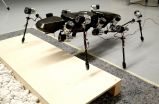INFORMATION:
The researchers used information from the National Center for Health Statistics 2010 Multiple Cause of Death data archive.
The Eunice Kennedy Shriver National Institute of Child Health and Human Development supported this work.
Main reason for lifespan variability between races not cause of death
2014-12-16
(Press-News.org) Eliminating health disparities between races is a goal of many groups and organizations, but a team of sociologists suggests that finding the reasons for the differences in the timing of black and white deaths may be trickier than once thought.
Life expectancies for black people are shorter and more uncertain, on average, than to those of whites, according to Glenn Firebaugh, Roy C. Buck Professor of American Institutions and professor of sociology and demography, Penn State. A higher lifespan variability -- the variability in the ages at which people die -- among blacks is usually explained by higher rates of certain causes of death, such as murder, which are more common among the young. However, the researchers found that higher rates of other causes of white deaths among the young appear to offset this.
"We initially suspected that the greater variance in lifespan for blacks would be a result of differences in the causes of death, for instance, the higher homicide rates among blacks," said Glenn Firebaugh. "But, as we looked closer, we saw that suicides and deaths due to drug poisoning -- deaths that are more common among whites -- offset the higher homicide rates for blacks."
Black homicide rates account for about 38 percent of the greater variance for blacks. However, the higher rates of white suicide and death due to drug overdose nearly cancels out the homicide effect, Firebaugh said.
Taken all together, differences in causes of death account for only about 13 percent of the difference in lifespan variability between blacks and whites, according to the researchers, who report their findings in the current issue of Demography.
"If you could magically change everything and make it so blacks and whites died of exactly the same causes, that would have surprisingly little effect on the difference in lifespan variability," said Firebaugh. "About 87 percent of the overall difference would persist."
In addition to behavioral reasons for lifespan uncertainty, researchers have also theorized that differences in medical treatment of and health prevention strategies for black and white patients may explain some of the difference in the variability of lifespan.
The researchers suggest that interventions to reduce this disparity may be more effective if they target sex, as well as race.
"With regard to policy, our results indicate the importance of sex-specific intervention to reduce racial disparities," the researchers said. "In the case of HIV/AIDS, for example, there is greater potential for significant reduction of the racial gap when men are targeted. The opposite is true for heart disease and diabetes, where interventions focused on women are more likely to narrow the gap."
Focusing on preventing specific causes of death, such as homicide and HIV/AIDS deaths, would help significantly cut the disparity. Eliminating the difference in deaths due to those two causes would cut the black-white disparity in lifespan variance by half, the researchers said.
Lifespan uncertainty is important because it may have a ripple effect for people and society, according to Firebaugh, who worked with Francesco Acciai, Aggie Noah, Christopher Prather, all graduate students in sociology and demography, Penn State and Claudia Nau, postdoctoral fellow in public health, the Johns Hopkins Global Centre for Childhood Obesity.
"This isn't part of the study, of course, but the uncertainty in lifespan could lead to uncertainty about the future," said Firebaugh. "One could imagine, for instance, that a consequence of people facing more uncertain lifespans would be that they change the way they plan, or don't plan, for health or education, for example, or for investing in retirement."
ELSE PRESS RELEASES FROM THIS DATE:
Previously removed immigrants more likely to be rearrested later, study finds
2014-12-16
Unauthorized immigrants who previously have been removed from the United States are more than 2.5 times more likely to be rearrested after leaving jail, and are likely to be rearrested much more frequently than those who have never been removed, according to a new RAND Corporation study.
The findings generally support strategies adopted by federal immigration authorities and some law enforcement agencies to focus their immigration enforcement efforts on immigrants who previously have been removed, who are viewed as posing a bigger criminal threat.
Researchers studied ...
Kent State Professor publishes exact solution to model Big Bang and quark gluon plasma
2014-12-16
Unlike in mathematics, it is rare to have exact solutions to physics problems.
"When they do present themselves, they are an opportunity to test the approximation schemes (algorithms) that are used to make progress in modern physics," said Michael Strickland, Ph.D., associate professor of physics at Kent State University.
Strickland and four of his collaborators recently published an exact solution in the journal Physical Review Letters that applies to a wide array of physics contexts and will help researchers to better model galactic structure, supernova explosions ...
Single genetic abnormality accelerates, removes the brakes on Ewing sarcoma tumor growth
2014-12-16
The genetic abnormality that drives the bone cancer Ewing sarcoma operates through two distinct processes - both activating genes that stimulate tumor growth and suppressing those that should keep cancer from developing. These findings by Massachusetts General Hospital (MGH) investigators, published in the November issue of Cancer Cell, may lead to new therapies targeting these aberrant mechanisms.
The second most common bone cancer in children and young adults, Ewing sarcoma is caused by a chromosomal translocation - switching of genetic segments between two different ...
Season's eatings
2014-12-16
EAST LANSING, Mich. - 'Tis the season of plenty of food and drink. While celebrating should be joyful, for some women, it's not. All the holiday temptations can add another layer to an already complicated biological process.
It's well known that women undergo hormonal changes every month due to the menstrual cycle. These changes can cause women to eat more, which is a natural, biological occurrence.
However, Michigan State University Foundation Professor Kelly Klump has found that the increased food intake causes some women to become much more preoccupied with their ...
Carbon-trapping 'sponges' can cut greenhouse gases
2014-12-16
ITHACA, N.Y. - In the fight against global warming, carbon capture - chemically trapping carbon dioxide before it releases into the atmosphere - is gaining momentum, but standard methods are plagued by toxicity, corrosiveness and inefficiency. Using a bag of chemistry tricks, Cornell materials scientists have invented low-toxicity, highly effective carbon-trapping "sponges" that could lead to increased use of the technology.
A research team led by Emmanuel Giannelis, the Walter R. Read Professor of Engineering in the Department of Materials Science and Engineering, has ...
Scientists trace nanoparticles from plants to caterpillars
2014-12-16
HOUSTON -- (Dec. 16, 2014) -- In one of the most comprehensive laboratory studies of its kind, Rice University scientists traced the uptake and accumulation of quantum dot nanoparticles from water to plant roots, plant leaves and leaf-eating caterpillars.
The study, one of the first to examine how nanoparticles move through human-relevant food chains, found that nanoparticle accumulation in both plants and animals varied significantly depending upon the type of surface coating applied to the particles. The research is available online in the American Chemical Society's ...
First steps for Hector the robot stick insect
2014-12-16
This news release is available in German. A research team at Bielefeld University has succeeded in teaching the only robot of its kind in the world how to walk. Its first steps have been recorded in a video. You can watch them in Bielefeld University's latest posting on 'research_tv'. The robot is called Hector, and its construction is modelled on a stick insect. Inspired by the insect, Hector has passive elastic joints and an ultralight exoskeleton. What makes it unique is that it is also equipped with a great number of sensors and it functions according to a biologically ...
New tracers can identify coal ash contamination in water
2014-12-16
DURHAM, N.C. - Duke University scientists have developed new forensic tracers to identify coal ash contamination in water and distinguish it from contamination coming from other sources.
"These new tools can be used by federal and state regulatory agencies to monitor the environmental effects of coal ash and determine whether it has or hasn't impacted the environment," said Avner Vengosh, professor of geochemistry and water quality at Duke's Nicholas School of the Environment. "They can be used to trace the coal ash effluents to their source, even in watersheds where ...
The simplest element: Turning hydrogen into 'graphene'
2014-12-16
Washington, D.C.--New work from Carnegie's Ivan Naumov and Russell Hemley delves into the chemistry underlying some surprising recent observations about hydrogen, and reveals remarkable parallels between hydrogen and graphene under extreme pressures. Their work is the cover story in the December issue of Accounts of Chemical Research.
Hydrogen is the most-abundant element in the cosmos. With only a single electron per atom, it is deceptively simple. As a result, hydrogen has been a testing ground for theories of the chemical bond since the birth of quantum mechanics ...
People may inherit 'gut' bacteria that cause Crohn's disease and ulcerative colitis
2014-12-16
MINNEAPOLIS/ST. PAUL (12/16/2014)--A new study by an international team of researchers shows for the first time that people may inherit some of the intestinal bacteria that cause Crohn's disease and ulcerative colitis, collectively know as inflammatory bowel disease (IBD). The study, recently published in Genome Medicine, also confirmed that antibiotics could worsen the imbalance in the gut microbes.
About 1.6 million Americans suffer from Crohn's disease or ulcerative colitis, according to the Crohn's and Colitis Foundation of America. Understanding the causes of these ...




